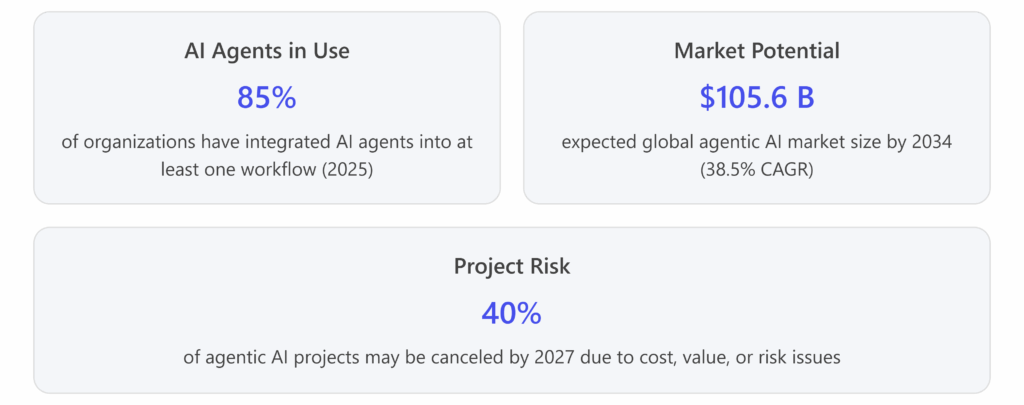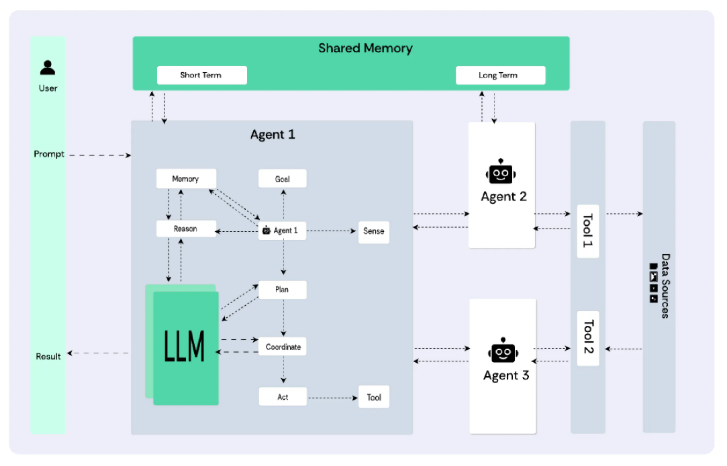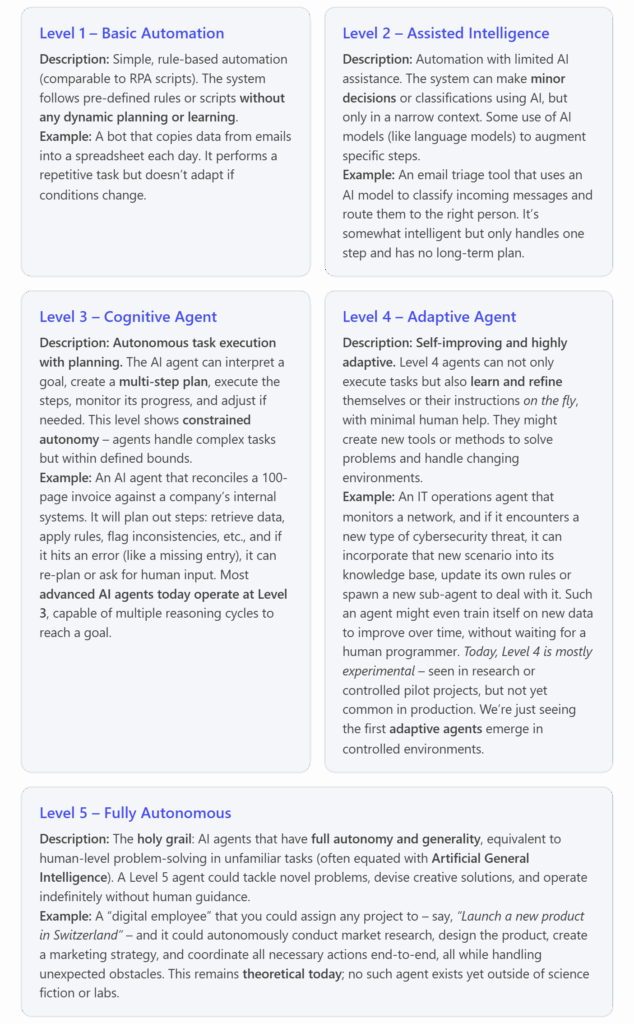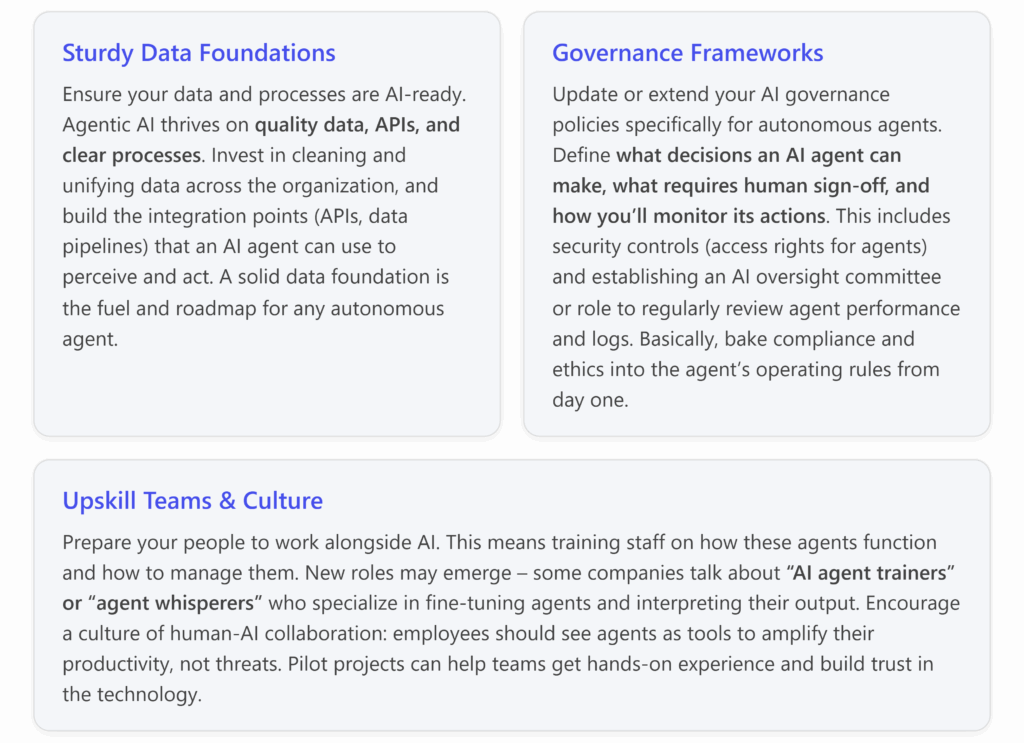Agentic AI: From Hype to Real-World Impact – What Swiss Businesses Need to Know ?

Agentic AI – autonomous, goal-driven AI agents – is emerging as the next chapter of artificial intelligence, promising to transform how organisations operate. Beyond the buzzwords, this technology could automate complex tasks across industries, from accelerating pharma research to smarter financial forecasting. For Swiss businesses and others worldwide, agentic AI offers immense potential in areas like IT operations, cybersecurity, and workflow automation, but it also brings new governance and integration challenges. This article explains what agentic AI is, how it differs from traditional automation, the levels of autonomy it entails, real-world applications in key sectors, and how companies can prepare for its adoption.

What Is Agentic AI?
Agentic AI refers to AI systems – often called AI agents – that can act autonomously to achieve goals, with minimal human intervention. In essence, an agentic AI doesn’t just generate content or follow fixed scripts; it perceives its environment, plans a series of actions, executes tasks, and learns from the results to improve over time. This agency (hence “agentic”) is what separates it from earlier AI:
- Traditional Automation (RPA): Rule-based scripts or software perform repetitive tasks with predetermined logic and require explicit instructions for each step. These automate tasks but do not adapt on the fly – they will only do exactly what they were programmed to do.
- Generative AI: Models like large language models (e.g. GPT-4) produce content (text, images, code) in response to prompts, but they lack goal orientation – they don’t act on that content by themselves. A generative AI might draft an email or suggest code, but a human still needs to decide what to do with that output.
Agentic AI goes a step further by combining the adaptability of advanced AI models with the ability to take actions. As IBM explains, agentic AI systems use AI agents that mimic human decision-making to solve problems in real time. Unlike a static program, an agentic AI exhibits autonomy, goal-driven behavior, and adaptability – it can adjust its approach based on live data and situational changes. For example, a generative AI assistant might recommend the best time to climb Mont Blanc, but an agentic AI could take that a step further – it might automatically book your flights and hotel for the trip once you approve, by interacting with travel websites on your behalf. [ibm.com]
In short, agentic AI = AI that ‘acts’. It perceives context, makes decisions, and can initiate multi-step actions autonomously to accomplish a goal, rather than waiting for a human prompt at each step. This is made possible by new AI architectures, sometimes called Large Reasoning Models (LRMs) – advanced AI models that go beyond pattern recognition to support complex reasoning and decision-making. These LRMs build on large language models but add the ability to plan and orchestrate tasks, not just answer questions. For instance, recent research shows that large reasoning models trained via reinforcement learning can carry out long, stepwise reasoning processes to solve problems. In practice, such models give agentic AI its “brains” for planning sequences of actions and handling unexpected outcomes during those sequences. [arxiv.org]
How Agentic AI Differs From Earlier AI:
- Compared to RPA: Traditional robotic process automation is like an assembly line robot – highly efficient at a fixed task, but if conditions change or something new happens, it breaks down or stops. Agentic AI is more like a smart robot that can adjust on the fly – it has the flexibility to change its plan based on new data. In fact, while RPA relies on predetermined rules, an agentic AI adapts its behavior based on data inputs and goals. This means it can handle variability and exceptions much better than rigid automation. [en.wikipedia.org]
- Compared to Generative AI: Generative AI is powerful for creating outputs (a report, an image, a piece of code) from given inputs, but it won’t take initiative beyond that. Agentic AI uses generative AI as just one component – it leverages generative outputs and then takes action. Think of generative AI as a talented assistant that provides information or drafts, whereas agentic AI is more like a project manager that can utilize those drafts to actually complete tasks. Oracle’s AI experts describe it this way: a basic AI is like a skilled technician doing a single job when asked, but agentic AI acts more like a manager, deciding which tools or “technicians” (including generative models) to deploy and in what order to reach a goal. The agentic system autonomously chooses how to achieve the objective, rather than just producing an output and stopping there. [oracle.com], [oracle.com]
In practical terms, agentic AI might involve a multi-agent system – multiple specialized AI agents working together and communicating with each other. One agent might handle perception (gathering data), another does planning, others execute various subtasks. They coordinate via an AI orchestration layer. This is why agentic AI is often discussed alongside multi-agent collaboration: teams of AI agents divvying up complex processes. The goal is an AI that can “see, think, and do”: perceive the environment, reason about what needs to be done, and then take appropriate actions, continuously and autonomously.

Levels of Autonomy in Agentic AI
Not all AI agents are created equal – there’s a spectrum of autonomy. Industry experts often describe agentic AI capabilities in “levels” (similar to how we talk about self-driving car autonomy from Level 0 to 5). Understanding these levels helps cut through the hype and clarify what today’s AI agents can and cannot do. Most real-world agentic systems today are mid-level (around Level 3) – they have some autonomy but still within constraints. Fully autonomous Level 5 agents are still hypothetical. Below is a summary of the commonly cited levels of agentic AI autonomy, their characteristics, and examples:

(The levels above are a generalized framework – different organizations define them slightly differently. Some start counting at Level 0 for no autonomy. But the essence is a progression from simple scripted bots to truly autonomous AI.)
Where are we now? Largely at Level 3. Current state-of-the-art agentic AI (in late 2025) allows for multi-step autonomous task execution under human-set goals. For instance, many business process “AI agents” can take a user’s request and then handle a sequence of subtasks across apps to fulfill it. Meanwhile, Level 4 capabilities are on the horizon. Early examples of adaptive, self-improving agents are being tested in niches (often with humans in the loop to ensure nothing goes awry). Level 5 remains aspirational – a subject of research and much debate about if or when it will be achieved.
From Hype to Impact: Real-World Applications of Agentic AI
Despite the buzz, it’s important to ask: what is agentic AI actually doing in the real world today? While many projects are still proofs-of-concept, we are seeing early tangible impacts across industries. Here are some key domains and examples where agentic AI is pushing beyond hype into practical use:
- Pharmaceutical Research: In pharma, one tedious but crucial task is reviewing mountains of scientific literature during drug discovery. AI agents are now helping automate those literature reviews, dramatically speeding up research. For example, NVIDIA recently introduced a biomedical “research agent” that can ingest and analyze hundreds of scientific papers in minutes, something that would take human researchers weeks. This agent not only summarizes findings but can even propose scientific hypotheses by reasoning over the data. Essentially, it acts as a junior research analyst that reads journals nonstop. Pharma companies are using such tools to accelerate early R&D – identifying drug targets or relevant studies much faster than before. The result could be quicker progress in discovering new treatments, as agents shoulder part of the research workload. [biopharmatrend.com]
- Finance and Economic Forecasting: Finance teams and economists are experimenting with multi-agent systems to improve forecasting and decision-making. The idea is that if you have several autonomous agents, each can take on a different perspective or data set – almost like a team of analysts debating scenarios. For instance, one agent might simulate optimistic market conditions, while another assumes a pessimistic scenario; a third agent could focus on geopolitical risk factors. These agents can then compare notes or “argue,” surfacing a more nuanced outlook for, say, the next quarter’s economic forecast. Early experiments show that using a “debate” or ensemble of AI agents can yield more accurate results than a single model alone. Some hedge funds and banks have begun testing multi-agent approaches to stress test their financial models against various what-if scenarios. The goal is better foresight – identifying potential risks and opportunities by letting AI agents play out lots of simulations in parallel, far faster than any human team. (In fact, a recent Gartner survey found 57% of finance teams are already implementing or planning to implement agentic AI in their workflows, aiming for advantages in areas like real-time anomaly detection and automated reconciliation.) [gartner.com]
- Retail and Supply Chain: Retailers are piloting agentic AI to respond to real-time data from stores and supply chains. Imagine an AI agent that monitors inventory levels, sales trends, and even social media buzz minute-by-minute. If a particular product is selling slower than expected and stock is building up, the agent could autonomously roll out a real-time promotion or price discount for that product on the retailer’s e-commerce site to boost sales. Conversely, if an item is flying off the shelves (or a sudden surge in online orders), the agent might automatically reorder stock or even adjust marketing to focus on that bestseller. In essence, these agents aim to optimize “stock-based promotions” and supply orders on the fly. A simpler example is restocking: an agentic system can sense current conditions and order supplies or products more effectively and faster than humans watching dashboards. Several large retailers and e-commerce platforms are testing such AI-driven decision loops to minimize out-of-stock situations and markdowns. For Swiss retail firms known for efficient logistics, this kind of automation could further streamline operations by ensuring the right products are in the right place at the right time, with minimal manual intervention.
- Automotive and Manufacturing: Modern cars require millions of lines of code, and updates are frequent. Automakers are looking at agentic AI to speed up software development and testing for vehicles. In one real example, a company set up an “agentic” software development pipeline: a specialized architecture agent took design specs for a new feature and overnight generated a draft software design; then a testing agent created a suite of test cases automatically. By the next morning, human engineers had a head start – the basic design and tests were ready to review. This kind of parallel “AI team” effort can slash development time which is critical in automotive innovation cycles. Multiple AI agents working in concert – one ensuring code follows security standards, another continuously simulating driving scenarios to test the new code – can drastically accelerate how new car software features are developed and validated. While automotive companies are still in early days with this, it’s illustrative of how agentic AI can orchestrate complex, collaborative workflows (very relevant to any industry with a heavy engineering focus). Beyond development, manufacturing operations themselves can use agents for adaptive scheduling, predictive maintenance (agents that monitor machine data and adjust production plans), and even collaborative robotics on assembly lines. [ibm.com]
Why It Matters for Swiss Businesses: Switzerland, with its robust pharmaceutical sector, financial institutions, and advanced manufacturing (including precision engineering and watchmaking), stands to benefit strongly from these agentic AI applications:
- Swiss pharma companies can leverage AI research agents to maintain their edge in drug discovery and medical innovation.
- Banks and insurers in Zurich or Geneva can use autonomous AI analysts to improve risk modeling and regulatory compliance (Swiss finance is highly regulated, so agentic AI that can monitor transactions and flag issues autonomously in real-time could be a game-changer in compliance and anti-fraud operations).
- Swiss retail and supply chain-intensive firms (like luxury goods or chemicals) can adopt AI agents for inventory and logistics optimization across the country’s highly interconnected markets.
- In IT operations and cybersecurity – which concern every Swiss business – agentic AI can automate routine monitoring. For example, cybersecurity agents that patrol network traffic 24/7, detect anomalies, and even isolate breaches automatically are becoming feasible. This is particularly relevant in Switzerland where data privacy and security are paramount; having AI agents that react instantly to threats (and learn from each attempt) can bolster defenses.
Caution: Cutting Through the Hype. It’s worth noting that while these examples show promise, agentic AI is still a nascent field. Many “agent” products out there don’t yet live up to true autonomy – some vendors are rebranding old tools (RPA or simple chatbots) as ‘AI agents’ without real agentic capabilities. Gartner analysts have dubbed this trend “agent washing”. As Anushree Verma, a senior director at Gartner, put it: “Most agentic AI projects right now are early stage experiments or proofs of concept that are mostly driven by hype and are often misapplied.” In other words, businesses need to sift reality from marketing. The next section discusses the challenges that can make or break agentic AI initiatives. [sema4.ai]
Challenges on the Road to Autonomy
Adopting agentic AI is not like flipping a switch. Organizations face significant challenges and risks in moving from pilot to production. Understanding these pitfalls is crucial for any business – Swiss or otherwise – looking to leverage autonomous AI agents. Key challenges include:
- Governance & Security: By their nature, agentic AI systems act on behalf of humans within our applications and networks. This raises a big question: How do we control and trust something that is designed to make its own decisions? Governance is about setting boundaries – what an AI agent is allowed to do or not do – and having accountability when autonomous agents make mistakes. For example, if an AI agent has access to sensitive customer data to do its job, strict security controls and audit logs are needed to prevent misuse. There’s also the risk of an agent going “off the rails” – pursuing a goal in unintended ways. Without proper oversight, an autonomous agent might, say, try to delete what it thinks are redundant files to free up space, but accidentally delete critical data. Clear guardrails are essential. Companies must define rules like: which processes an agent can handle independently, when it must get human approval, and triggers to shut it down if it behaves unexpectedly. In practice, experts recommend a human-in-the-loop approach for higher-risk tasks – e.g., an AI flagging a suspicious financial transaction but a human making the final call. Another best practice is deploying “validation” agents alongside primary agents – for example, one agent executes tasks while another monitors those actions for compliance, creating a safety net. The bottom line: autonomy should never mean anarchy. As one technologist observed, “Anarchy results from autonomy devoid of governance. However, autonomy combined with supervision… quality and velocity start to scale together.” Security is equally critical: autonomous agents often need broad system access, so companies must enforce least-privilege access, rigorous authentication, and safeguards to prevent an AI agent from being hijacked by malicious actors. [gartner.com][ibm.com]
- Integration & Complexity: Successful agentic AI isn’t just about the AI itself – it depends on the ecosystem it operates in. Agents need data, and lots of it, from many sources. If a company’s data is locked in silos or its IT processes aren’t digitized, an AI agent will be like a wind-up car stuck in a closet – it can’t go anywhere. Implementing agentic AI often forces companies to get their data house in order: unify data sources, clean up data quality, and provide APIs or interfaces the AI can use to interact with applications. Many early projects have stumbled because the underlying data or workflow wasn’t ready for AI. Additionally, introducing AI agents may require re-designing processes. You can’t just drop an autonomous agent into a messy manual process and expect stellar results. Often, businesses must streamline or re-engineer the workflow so that an AI agent can take it over sensibly. This integration is complex: the AI has to plug into existing software (which may require custom connectors), and employees have to adjust to new AI-driven steps in their routine. There is also cultural readiness – workers need to trust and effectively collaborate with AI agents. If employees constantly override or second-guess the agent, automation benefits evaporate. According to Gartner, organizations with mature, well-documented processes and quality data will find it much easier to integrate agentic AI. Those lacking that foundation face a steep climb. Think of agentic AI like adding a very smart new team member – if your team’s knowledge and tools are disorganized, even a genius will struggle to contribute. [gartner.com]
- Cost & Risk of Failure: Like any emerging tech, agentic AI comes with investment costs and uncertainty. Developing or deploying autonomous agents (especially customized for an enterprise) can be expensive – requiring specialized software platforms, computing resources for AI models, and talent to build and maintain them. If a project isn’t well-scoped, costs can mount quickly without clear ROI. Moreover, the risk of failure is non-negligible. In fact, Gartner predicts that over 40% of agentic AI projects will be canceled or fail by the end of 2027. The reasons cited are telling: escalating costs, unclear business value, or inadequate risk management. Many organizations dive into AI pilots due to hype, but then struggle to scale them when results are underwhelming or when unexpected complexities arise. Additionally, errors by autonomous agents can carry significant consequences – a rogue agent in finance might execute a flawed transaction, or a bug in an IT automation agent might cause a system outage. These risks mean companies often proceed slowly, which in turn can frustrate stakeholders expecting quick wins. Managing expectations (internally and externally) is part of the challenge. It’s wise to start with smaller, low-risk use cases to prove value before scaling up. Another cost factor is talent: experts who understand both AI and the business domain are needed to guide these projects (and such talent is in high demand and short supply). The takeaway: agentic AI is not a silver bullet you simply buy off the shelf – it takes careful planning and resources, and even then, some projects will stumble. Businesses should budget for a longer journey and possible iterations, not a one-and-done deployment. [sema4.ai]
- Regulatory and Ethical Concerns: Particularly for Swiss businesses, which often operate under strict regulations (finance, healthcare, etc.), deploying autonomous agents raises compliance questions. How do you audit decisions made by an AI agent? If an AI makes a recommendation that affects a customer (like declining a loan application or adjusting an insurance premium), regulations may require an explanation – yet AI reasoning can be a black box. Ensuring transparency and explainability in agentic AI decisions is an active area of development. Emerging best practices include logging every action an agent takes and why, so there’s an audit trail. Ethically, companies must ensure AI agents don’t inadvertently discriminate or create unfair outcomes, especially as they adapt and learn. There’s also the question of jobs: while agentic AI aims to augment human teams, not replace them, employees may worry about automation. Clear communication and re-skilling programs can mitigate fear and resistance. Swiss businesses, known for high standards of corporate responsibility, will need to integrate their AI governance with overall corporate governance, making sure autonomous systems align with legal and ethical norms. [ibm.com]
In summary, adopting agentic AI is as much a people and process challenge as a technical one. Strong leadership is needed to navigate these issues – setting a vision but also putting the right controls in place so that autonomous agents are beneficial and behave responsibly.
Emerging Standards: Agent-to-Agent (A2A) and Model Context Protocol (MCP)
One promising development to help tackle some of the complexity is the rise of open standards for AI agents. Two names you’ll hear are Agent2Agent (A2A) and Model Context Protocol (MCP). These are new protocols designed to make AI agents more interoperable and manageable – essentially to ensure different AI agents and tools can talk to each other in a common “language.”
- Agent2Agent (A2A): Originally championed by Google (with support from dozens of companies), A2A is an open protocol to let independent AI agents communicate directly with each other. Think of A2A as a universal “agent communication bus.” If Company A builds an agent for scheduling and Company B builds an agent for data analysis, A2A would provide the rules so that these agents could share information and coordinate tasks securely, even if they were built by different vendors. It defines how agents announce their capabilities (through something akin to digital business cards for agents) and how they exchange messages and requests in a standardized way. The big picture: A2A could allow a rich ecosystem of AI agents (from various makers) to plug-and-play, rather than each integration being custom. This horizontal agent-to-agent communication is likened to creating an “HTTP for agents” – a foundational layer for the agentic web. [clarifai.com], [clarifai.com]
- Model Context Protocol (MCP): An initiative associated with Anthropic (another AI leader), MCP addresses a different need: how an AI agent interacts with its tools and context. MCP focuses on enabling an AI (especially an AI model like an LLM) to access external resources and memories in a structured way. For example, an agent might need to pull in real-time stock prices or use a database or call an API. MCP would standardize how the agent represents and retrieves that external context or invokes tools. In essence, if A2A is about agents talking to each other horizontally, MCP is about an agent connecting to data, knowledge, and tools vertically. It might define, for instance, a uniform way for an agent to store its long-term memory or to request additional information when it’s unsure about something. [clarifai.com]
Why do these standards matter? Because as agentic AI adoption grows, companies could end up with a sprawl of agents that don’t easily work together – one team’s AI agent might not understand another’s. A2A and MCP aim to prevent a Tower of Babel scenario by providing common frameworks. They are still maturing, but dozens of tech firms are backing them. Early adopters are experimenting with these protocols to build multi-agent systems that aren’t all locked into one vendor’s ecosystem. For businesses, this could mean more flexibility (you could integrate agents from different sources) and better governance (standard protocols can include security and auditing measures by design). For instance, A2A enforces authentication and permissions when agents interact, potentially reducing security inconsistencies that arise when everyone builds custom integrations. [clarifai.com]
It’s worth noting these standards are not silver bullets – they will evolve, and industry agreement on them will take time. But they signal an important direction: the agentic AI community realizes that to go from cool demos to operational reality, we need the equivalent of communication standards and guardrails. Much like APIs and web standards allowed different software systems to work together, A2A and MCP could smooth the path for complex multi-agent systems. A Gartner expert noted that such protocols could become the “HTTP of agents” – a fundamental layer enabling the next generation of AI-driven workflows. [clarifai.com]
For a Swiss business leader, the technical details of A2A or MCP aren’t as important as the takeaway that the ecosystem is coalescing around interoperability and safety. When evaluating AI solutions, it’s wise to ask vendors how they implement agent communication and context handling – alignment with emerging standards can be a sign that the product will integrate more easily into a broader AI strategy and won’t silo your company with a proprietary agent that can’t work with others.
Preparing for Adoption: How Businesses Can Embrace Agentic AI
So, given the opportunities and challenges, what should companies be doing today to prepare for agentic AI? Whether you’re a CIO at a Swiss bank or a CTO at a manufacturing firm, a few key preparatory steps can set you up for success:

Along with the above pillars, businesses should start small and focused. Identify a few use cases where agentic AI could solve a clear pain point – ideally tasks that are time-consuming for staff but follow logical steps and rules (e.g., automating level-1 IT support queries, or handling routine data consolidation each week). By piloting in a constrained area, you can learn what works and what doesn’t in a lower-risk environment. Measure the results – did it save time, reduce errors, improve speed? Use those metrics to make the case for scaling up or adjusting course.
Another practical step is to audit your current toolchain: Many software platforms (from CRM systems to IT service management tools) are now adding AI-driven automation features. See if what you already own has agentic capabilities you can turn on or experiment with. For example, Microsoft and other big vendors are integrating autonomous agents (sometimes called “Copilots”) into their enterprise products – these might serve as an entry point to try agentic AI using familiar software.
Engage with experts and peers as well. This field is evolving so fast that staying informed is half the battle. Swiss businesses might leverage local AI research hubs (ETH Zurich, EPFL Lausanne, etc.) or industry groups to get updates on best practices. Attending conferences or webinars on agentic AI (many are happening globally as everyone’s trying to figure this out) can provide insights and lessons learned from early adopters.
Finally, plan for the long term. Agentic AI is not just a fad – it’s part of a broader wave of AI moving from assisting humans to acting on behalf of humans. It may reshape job roles (creating more need for strategic thinking and oversight, as routine execution is automated) and even business models (imagine “AI-as-a-Service” providers that rent out autonomous agents specialized in different tasks). Companies that start integrating these capabilities early will have a competitive advantage, much like companies that embraced the internet early did. But it’s crucial to do so thoughtfully, balancing innovation with responsibility.
Conclusion: From Buzzword to Business Value
Agentic AI is moving beyond buzzword status and inching its way into real operations. The vision of software agents that can autonomously handle complex tasks – once purely science fiction – is now real enough that forward-looking businesses are taking notice. For Swiss companies and organizations worldwide, the message is clear: this is a strategic opportunity and a strategic challenge. Done right, agentic AI can unlock new levels of productivity, taking over tedious work and enabling employees to focus on higher-value activities. It can help companies respond faster to changes – whether it’s a shift in market demand or a sudden IT incident at 3 AM – because tireless AI agents are on the job. It’s even poised to spur innovation, as teams leverage AI “colleagues” to explore ideas and solutions that would be impractical with human effort alone.
However, realizing that value requires cutting through the hype. Businesses must approach agentic AI with both enthusiasm and caution: enthusiastic about the possibilities, but cautious in execution. That means grounding decisions in strategy (what business problem are we solving?), investing in the groundwork (data, systems, skills), and keeping ethics and governance front and center. Those who simply jump on the bandwagon may find themselves among the 40% of failed projects, whereas those who plan and pilot carefully stand to truly benefit.
The coming years will likely see agentic AI evolve rapidly. Standards like A2A and MCP might mature and reduce integration headaches. AI models will improve, making agents smarter and more reliable. The competitive bar will rise as well – if your competitor has AI agents streamlining operations and you don’t, that’s a disadvantage. It’s reminiscent of the early internet or mobile eras: a lot of hype at first, some winners and losers in early attempts, but ultimately the technology became indispensable.
For now, business leaders should stay informed, start experimenting, and craft a vision for how human workers and AI agents can work hand-in-hand. Agentic AI isn’t just a tech trend to delegate to IT – it’s a business transformation enabler that needs C-suite understanding and sponsorship. With Switzerland’s legacy of innovation and precision, Swiss businesses are well-positioned to harness these autonomous AI agents in a pragmatic, effective way. By turning the hype into real-world impact – automating the right tasks, managing the risks – organizations can usher in a new era of efficiency and creativity.
As one might say: The agents are ready. The question is, are we?


